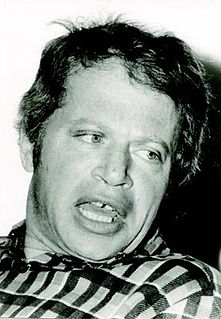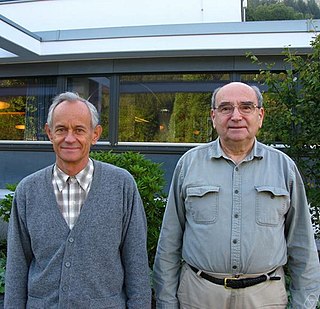
Vladimir Igorevich Arnold was a Soviet and Russian mathematician. While he is best known for the Kolmogorov–Arnold–Moser theorem regarding the stability of integrable systems, he made important contributions in several areas including dynamical systems theory, algebra, catastrophe theory, topology, algebraic geometry, symplectic geometry, differential equations, classical mechanics, hydrodynamics and singularity theory, including posing the ADE classification problem, since his first main result—the solution of Hilbert's thirteenth problem in 1957 at the age of 19. He co-founded two new branches of mathematics—KAM theory, and topological Galois theory.

Prof Sergei Lvovich Sobolev HFRSE was a Soviet mathematician working in mathematical analysis and partial differential equations.

Andrey Nikolayevich Tikhonov was a Soviet and Russian mathematician and geophysicist known for important contributions to topology, functional analysis, mathematical physics, and ill-posed problems. He was also one of the inventors of the magnetotellurics method in geophysics. Other transliterations of his surname include "Tychonoff", "Tychonov", "Tihonov", "Tichonov."

Nikolai Dmitrievich Brashman was a Russian mathematician of Jewish-Austrian origin. He was a student of Joseph Johann Littrow, and the advisor of Pafnuty Chebyshev and August Davidov.
Georgy Maximovich Adelson-Velsky was a Soviet and Israeli mathematician and computer scientist.

Dmitri Fyodorovich Egorov was a Russian and Soviet mathematician known for contributions to the areas of differential geometry and mathematical analysis. He was President of the Moscow Mathematical Society (1923–1930).

Ivan Georgievich Petrovsky was a Soviet mathematician working mainly in the field of partial differential equations. He greatly contributed to the solution of Hilbert's 19th and 16th problems, and discovered what are now called Petrovsky lacunas. He also worked on the theories of boundary value problems, probability, and on the topology of algebraic curves and surfaces.

The Saint Petersburg Mathematical Society is a mathematical society run by Saint Petersburg mathematicians.
Felix Earl Browder was an American mathematician known for his work in nonlinear functional analysis. He received the National Medal of Science in 1999 and was President of the American Mathematical Society until 2000. His two younger brothers also became notable mathematicians, William Browder and Andrew Browder.
Matematicheskii Sbornik is a peer reviewed Russian mathematical journal founded by the Moscow Mathematical Society in 1866. It is the oldest successful Russian mathematical journal. The English translation is Sbornik: Mathematics. It is also sometimes cited under the alternative name Izdavaemyi Moskovskim Matematicheskim Obshchestvom or its French translation Recueil mathématique de la Société mathématique de Moscou, but the name Recueil mathématique is also used for an unrelated journal, Mathesis. Yet another name, Sovetskii Matematiceskii Sbornik, was listed in a statement in the journal in 1931 apologizing for the former editorship of Dmitri Egorov, who had been recently discredited for his religious views; however, this name was never actually used by the journal.

Victor Anatolyevich Vassiliev or Vasilyev, is a Soviet and Russian mathematician. He is best known for his discovery of the Vassiliev invariants in knot theory, which subsume many previously discovered polynomial knot invariants such as the Jones polynomial. He also works on singularity theory, topology, computational complexity theory, integral geometry, symplectic geometry, partial differential equations, complex analysis, combinatorics, and Picard–Lefschetz theory.

Simon Grigorevich Gindikin is a mathematician at Rutgers University who introduced the Gindikin–Karpelevich formula for the Harish-Chandra c-function.

August Yulevich Davidov was a Russian mathematician and engineer, professor at Moscow University, and author of works on differential equations with partial derivatives, definite integrals, and the application of probability theory to statistics, and textbooks on elementary mathematics which were repeatedly reprinted from the 1860s to the 1920s. He was president of the Moscow Mathematical Society from 1866 to 1885.
Pyotr Lavrentyevich Ulyanov was a Russian mathematician working on analysis.
Aleksandr Adol'fovich Buchstab was a Soviet mathematician who worked in number theory and was "known for his work in sieve methods". He is the namesake of the Buchstab function, which he wrote about in 1937.
Evgenii Mikhailovich Nikishin was a Russian mathematician, who specialized in harmonic analysis.

Moscow State School 57 is a public school located in the Khamovniki District of Moscow, Russia. The school was founded in 1877 and is best known for its specialized secondary program in mathematics and its alumni.
Andrey Aleksandrovich Gonchar, was a Soviet and Russian mathematician, specializing in analysis.

Boris Samuel Mityagin is a Russian-American mathematician.












